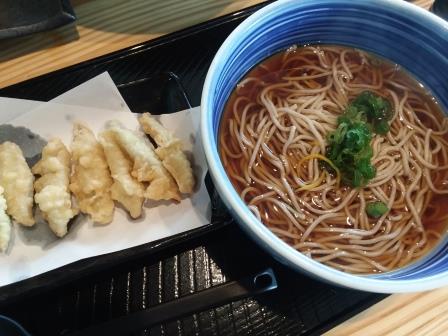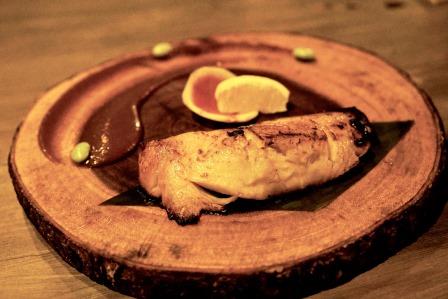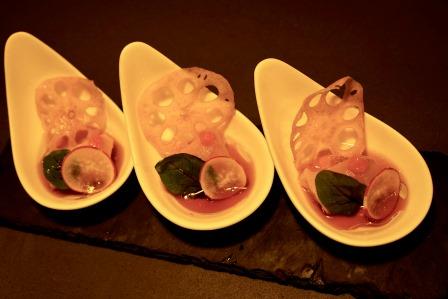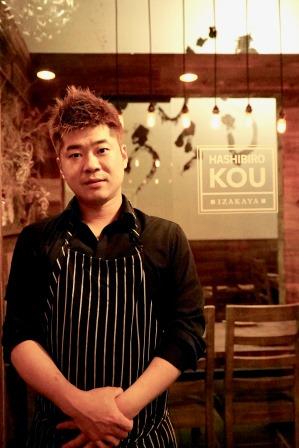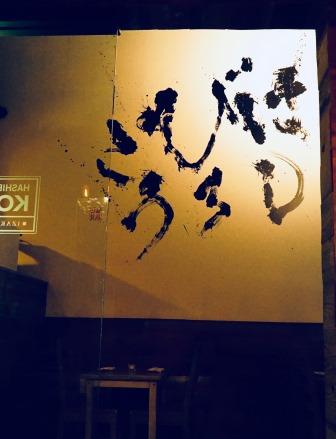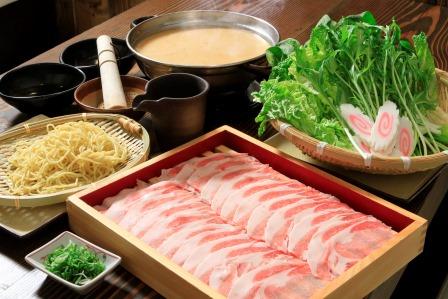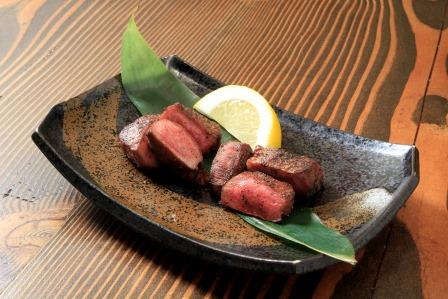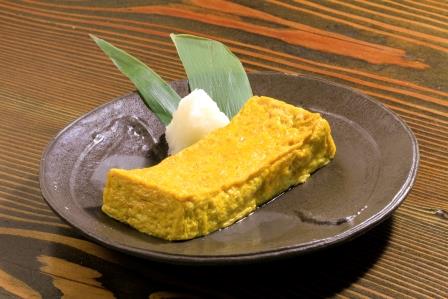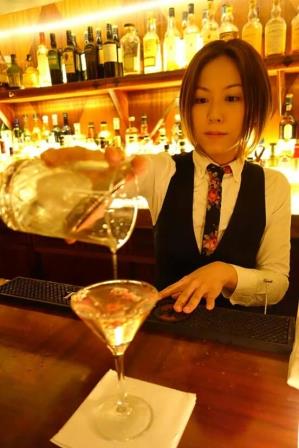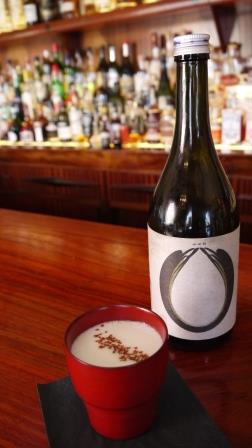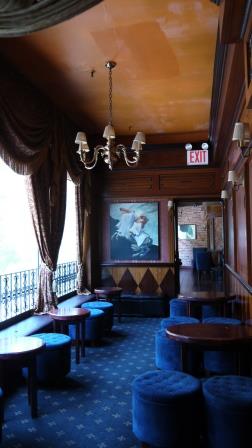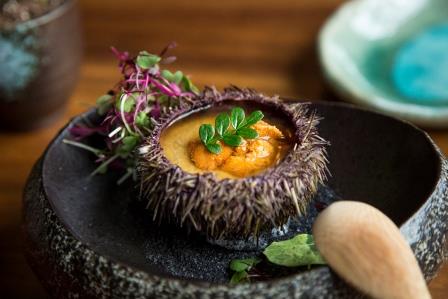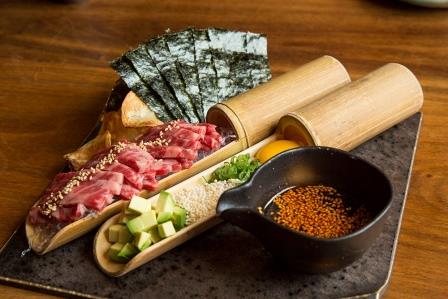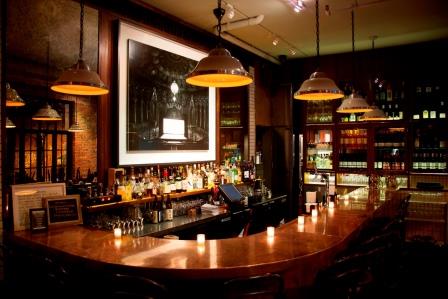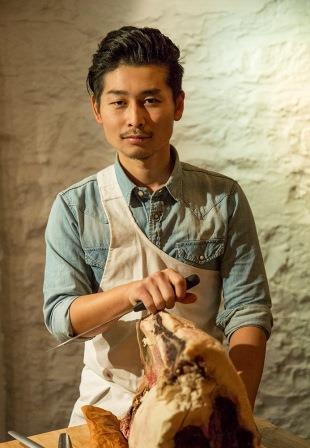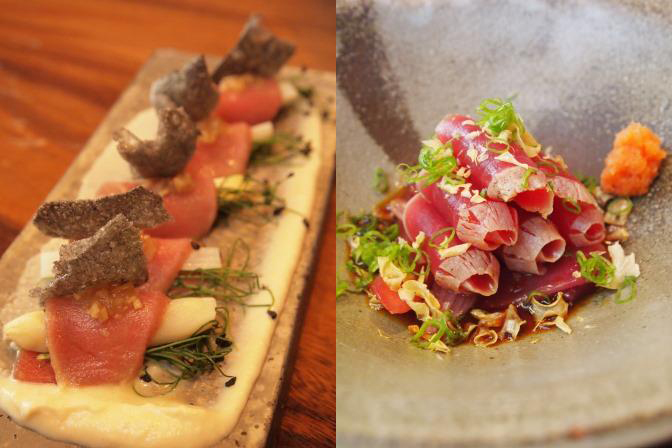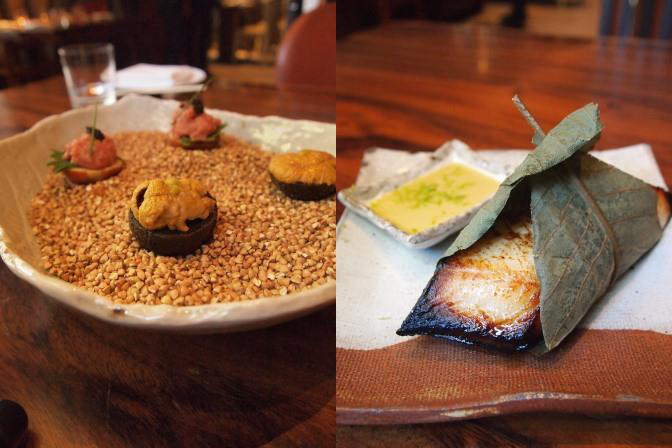Running for several decades as a diner in the day time, and an izakaya at night time
By Keiko Fukuda
In 1992, I came to Los Angeles initially to spend a long holiday after quitting a publishing company in Tokyo. However, 6 months later, I ended up staying for a while because I had an opportunity to work for a Japanese community magazine, and also acquired a working visa. The office was located in Gardena, a southern suburb of Los Angeles, where many Japanese and Japanese Americans live. The restaurant, to which my coworker took me on my first day at work, was Azuma, which was located on the same street as my office.
Their menu contained dishes which were similar to those of diners in Japan.
However, I was astonished by unexpectedly large volume of the dishes I ordered when they were delivered in front of me. I thought it could be only my imagination, but after that, it seemed like volume was getting larger and larger every time I visited.
In 2003, I quit this first company and became a freelance writer. I was visiting Azuma less often after that, and started to visit the restaurant occasionally at night while they were operating as an izakaya rather than during lunch time.
Azuma was always crowded as it was before, every time I visited. There was an aikido dojo right across from Azuma on Western Street, where my son used to take lessons 3 times a week. When I was waiting for my son outside of the dojo in those evenings, I used to smell delicious grilled fish from across the street.
More than a quarter century has passed since I first visited Azuma. What is their secret for being loved for so long in the South Bay as a Japanese restaurant and as an izakaya as well? I asked for permission to interview the owner. The current owner is Hideki Obayashi, and he is a third-generation Japanese American. He runs the restaurant with a partner, Frank Nakano. He said that they bought Azuma from the previous owner in 2002.
“I overheard a waitress at Azuma saying “the restaurant is on sale”. As an izakaya of Gardena, it was the only one back then, so it sounded very appealing, and I made a bid with Frank. We were the third bidders, but we were lucky enough to become the new owners.”
He said that ever since they took over, the restaurant has continued to run smoothly without losing the lasting reputation as a popular restaurant. “Recently, Yelp has been helping a lot. Most of the customers write quite highly about us. Once in a while, we get a bad review, but it seems to me that some competitor is just trying to pull our legs because we are so confident about our foods and services,” says Hideki wearing a confident smile.
They have not changed the basic menu since the time of the previous owner. They just made small changes to accommodate customers’ requests. As for the popular items, he says, “Caucasian customers like rib-eye steak and sashimi.
Third-generation Japanese Americans prefer curry or omelet-rice over usual combination dishes. And, health-conscious customers surely love grilled fish such as saury, mackerel, and salmon, and sashimi. For those who drink, we have a comprehensive izakaya-style menu, and we carry all the Japanese popular beer brands; Asahi, Sapporo, and Kirin,” he answered. I said, “Why don’t you carry Orion beer? There is the North American Okinawa Kenjin-Kaikan Hall right in the neighborhood.” “Sure enough! We should check into it,” said Hideki, diligently taking notes, showing his enthusiasm of the business.
Well, it has been already 17 years since Hideki and Frank took over. I asked the reason for their ever-lasting popularity that keeps appealing to even repeating customers. He answered, “There are three. First, a rich and wide variety of menu items. Second, large volumes of food. Lastly, excellent service by our servers. The last, third point is especially difficult to achieve. We are always asking around to look for good candidates.”
Several blocks down south on Western Street from where Azuma is located, there used to be Toyota’s headquarters until 3 years ago. Although the population of surrounding Japanese and Japanese food lovers also moved away with Toyota, Azuma seems to keep busy by winning a wide variety of customers’ hearts with their good food.
昼は定食屋、夜は居酒屋で数十年
1992年、東京の出版社を辞めた私は、長期の休暇を過ごすような気持ちでロサンゼルスにやって来た。しかし、渡米半年後に日本語の情報誌で働ける機会とビザを得て在留することになった。その職場は日系人や日本人が多く暮らすロサンゼルス南郊のガーデナにあった。そして、初日のランチタイムに職場の先輩が連れて行ってくれたレストランが、同じ通り沿いの吾妻だった。
日本の定食屋と同じようなメニューが並んでいた。しかし、オーダーした料理を実際に目の前にすると予想外のボリュームに驚かされた。その後、店を訪れるたびにボリュームが増え続けるように感じたのは気のせいだったのだろうか。
その後、2003年に最初に勤めた会社を辞めてフリーランスのライターになってからは以前より頻度は落ちたものの、ランチではなく夜に時折、居酒屋として利用するようになった。そして、いつ訪れても吾妻は変わらず繁盛していた。また、ウエスターン通りを挟んだ真向かいに、息子が週3日通う合気道の道場があった。夕方、息子の稽古を道場の外で待っていると、通りの向こう側から焼き魚の美味しそうな香りが漂ってきたものだ。
私が最初に吾妻を訪ねてから四半世紀以上が経った。サウスベイで変わらず日本食レストラン兼居酒屋として愛されている秘密は何か、オーナーに話を聞こうと取材を申し込んだ。現オーナーのヒデキ・オオバヤシさんは日系3世。フランク・ナカノさんとの共同経営で、前のオーナーから吾妻を2002年に買い取ったそうだ。
「吾妻のウエイトレスから、『店が売りに出ている』を耳にして、ガーデナの居酒屋としては当時、唯一の店だったから、魅力的に感じてフランクと名乗りを挙げました。買いたいと言ったのは僕たちで3組目だったんですが、運よく、僕たちが新しいオーナーになれました」
以降、ヒデキさんたちが引き継いでも、それまでの人気レストランとしての評価を下げることなく経営は順調に推移して来たと話す。「ここ最近はYelpが非常に役に立っています。ほとんどのお客さんが高い評価をつけてくれますからね。時折、低い評価もあるけれど、あれは競合店が足を引っ張っているんじゃないかって思うほど、自分たちの料理やサービスに自信を持っています」とヒデキさんは余裕の笑顔だ。
前オーナーの時代から基本的にはメニューを変えていないが、顧客の要望で一部のみ変更したとのことだ。人気の品は「白人の顧客にはリブアイステーキや刺身がよく出ます。日系3世になると一般的なコンビネーションより、むしろカレーやオムライスをオーダーする人が多いです。また、健康志向の人にはやはり、サンマ、サバ、サーモンなどの焼き魚や刺身ですね。お酒を飲む人向けには居酒屋メニューが充実しているし、ビールはアサヒ、サッポロ、キリンと日本のブランドを全て取り揃えています」と答えた。「オリオンビールは置いていないのですか?すぐそこに北米沖縄県人会館があるのに」という問いに対して、「確かにそうですね。検討しなくては」と早速メモを取るヒデキさんの姿に、商売熱心な姿勢が見えた。
さて、ヒデキさんとフランクさんの代になってすでに17年、昔と変わらず人気店としてリピーターを引き付けている理由を聞いた。「3つあります。まず、メニューの種類が多いこと。次にボリュームがあること。最後にサーバーの対応が良いことです」。3番目の人材は特に難しいポイントで、常にいい人がいないか、人に聞いて探していると話す。
吾妻の場所からウエスターン通りを数ブロック南下した場所には、3年前まで北米トヨタの本社があった。トヨタの移転と共に周囲の日本人人口、そして日本食の愛好者の人口も流出したが、吾妻は幅広い層の顧客の胃袋を掴むことで変わらず繁盛を続けているようだ。
Azuma
16123 S Western Ave Gardena, CA 90247
(310) 532-8623
In 1992, I came to Los Angeles initially to spend a long holiday after quitting a publishing company in Tokyo. However, 6 months later, I ended up staying for a while because I had an opportunity to work for a Japanese community magazine, and also acquired a working visa. The office was located in Gardena, a southern suburb of Los Angeles, where many Japanese and Japanese Americans live. The restaurant, to which my coworker took me on my first day at work, was Azuma, which was located on the same street as my office.
Their menu contained dishes which were similar to those of diners in Japan.
However, I was astonished by unexpectedly large volume of the dishes I ordered when they were delivered in front of me. I thought it could be only my imagination, but after that, it seemed like volume was getting larger and larger every time I visited.
In 2003, I quit this first company and became a freelance writer. I was visiting Azuma less often after that, and started to visit the restaurant occasionally at night while they were operating as an izakaya rather than during lunch time.
Azuma was always crowded as it was before, every time I visited. There was an aikido dojo right across from Azuma on Western Street, where my son used to take lessons 3 times a week. When I was waiting for my son outside of the dojo in those evenings, I used to smell delicious grilled fish from across the street.
More than a quarter century has passed since I first visited Azuma. What is their secret for being loved for so long in the South Bay as a Japanese restaurant and as an izakaya as well? I asked for permission to interview the owner. The current owner is Hideki Obayashi, and he is a third-generation Japanese American. He runs the restaurant with a partner, Frank Nakano. He said that they bought Azuma from the previous owner in 2002.
“I overheard a waitress at Azuma saying “the restaurant is on sale”. As an izakaya of Gardena, it was the only one back then, so it sounded very appealing, and I made a bid with Frank. We were the third bidders, but we were lucky enough to become the new owners.”
He said that ever since they took over, the restaurant has continued to run smoothly without losing the lasting reputation as a popular restaurant. “Recently, Yelp has been helping a lot. Most of the customers write quite highly about us. Once in a while, we get a bad review, but it seems to me that some competitor is just trying to pull our legs because we are so confident about our foods and services,” says Hideki wearing a confident smile.
They have not changed the basic menu since the time of the previous owner. They just made small changes to accommodate customers’ requests. As for the popular items, he says, “Caucasian customers like rib-eye steak and sashimi.
Third-generation Japanese Americans prefer curry or omelet-rice over usual combination dishes. And, health-conscious customers surely love grilled fish such as saury, mackerel, and salmon, and sashimi. For those who drink, we have a comprehensive izakaya-style menu, and we carry all the Japanese popular beer brands; Asahi, Sapporo, and Kirin,” he answered. I said, “Why don’t you carry Orion beer? There is the North American Okinawa Kenjin-Kaikan Hall right in the neighborhood.” “Sure enough! We should check into it,” said Hideki, diligently taking notes, showing his enthusiasm of the business.
Well, it has been already 17 years since Hideki and Frank took over. I asked the reason for their ever-lasting popularity that keeps appealing to even repeating customers. He answered, “There are three. First, a rich and wide variety of menu items. Second, large volumes of food. Lastly, excellent service by our servers. The last, third point is especially difficult to achieve. We are always asking around to look for good candidates.”
Several blocks down south on Western Street from where Azuma is located, there used to be Toyota’s headquarters until 3 years ago. Although the population of surrounding Japanese and Japanese food lovers also moved away with Toyota, Azuma seems to keep busy by winning a wide variety of customers’ hearts with their good food.
昼は定食屋、夜は居酒屋で数十年
1992年、東京の出版社を辞めた私は、長期の休暇を過ごすような気持ちでロサンゼルスにやって来た。しかし、渡米半年後に日本語の情報誌で働ける機会とビザを得て在留することになった。その職場は日系人や日本人が多く暮らすロサンゼルス南郊のガーデナにあった。そして、初日のランチタイムに職場の先輩が連れて行ってくれたレストランが、同じ通り沿いの吾妻だった。
日本の定食屋と同じようなメニューが並んでいた。しかし、オーダーした料理を実際に目の前にすると予想外のボリュームに驚かされた。その後、店を訪れるたびにボリュームが増え続けるように感じたのは気のせいだったのだろうか。
その後、2003年に最初に勤めた会社を辞めてフリーランスのライターになってからは以前より頻度は落ちたものの、ランチではなく夜に時折、居酒屋として利用するようになった。そして、いつ訪れても吾妻は変わらず繁盛していた。また、ウエスターン通りを挟んだ真向かいに、息子が週3日通う合気道の道場があった。夕方、息子の稽古を道場の外で待っていると、通りの向こう側から焼き魚の美味しそうな香りが漂ってきたものだ。
私が最初に吾妻を訪ねてから四半世紀以上が経った。サウスベイで変わらず日本食レストラン兼居酒屋として愛されている秘密は何か、オーナーに話を聞こうと取材を申し込んだ。現オーナーのヒデキ・オオバヤシさんは日系3世。フランク・ナカノさんとの共同経営で、前のオーナーから吾妻を2002年に買い取ったそうだ。
「吾妻のウエイトレスから、『店が売りに出ている』を耳にして、ガーデナの居酒屋としては当時、唯一の店だったから、魅力的に感じてフランクと名乗りを挙げました。買いたいと言ったのは僕たちで3組目だったんですが、運よく、僕たちが新しいオーナーになれました」
以降、ヒデキさんたちが引き継いでも、それまでの人気レストランとしての評価を下げることなく経営は順調に推移して来たと話す。「ここ最近はYelpが非常に役に立っています。ほとんどのお客さんが高い評価をつけてくれますからね。時折、低い評価もあるけれど、あれは競合店が足を引っ張っているんじゃないかって思うほど、自分たちの料理やサービスに自信を持っています」とヒデキさんは余裕の笑顔だ。
前オーナーの時代から基本的にはメニューを変えていないが、顧客の要望で一部のみ変更したとのことだ。人気の品は「白人の顧客にはリブアイステーキや刺身がよく出ます。日系3世になると一般的なコンビネーションより、むしろカレーやオムライスをオーダーする人が多いです。また、健康志向の人にはやはり、サンマ、サバ、サーモンなどの焼き魚や刺身ですね。お酒を飲む人向けには居酒屋メニューが充実しているし、ビールはアサヒ、サッポロ、キリンと日本のブランドを全て取り揃えています」と答えた。「オリオンビールは置いていないのですか?すぐそこに北米沖縄県人会館があるのに」という問いに対して、「確かにそうですね。検討しなくては」と早速メモを取るヒデキさんの姿に、商売熱心な姿勢が見えた。
さて、ヒデキさんとフランクさんの代になってすでに17年、昔と変わらず人気店としてリピーターを引き付けている理由を聞いた。「3つあります。まず、メニューの種類が多いこと。次にボリュームがあること。最後にサーバーの対応が良いことです」。3番目の人材は特に難しいポイントで、常にいい人がいないか、人に聞いて探していると話す。
吾妻の場所からウエスターン通りを数ブロック南下した場所には、3年前まで北米トヨタの本社があった。トヨタの移転と共に周囲の日本人人口、そして日本食の愛好者の人口も流出したが、吾妻は幅広い層の顧客の胃袋を掴むことで変わらず繁盛を続けているようだ。
Azuma
16123 S Western Ave Gardena, CA 90247
(310) 532-8623








